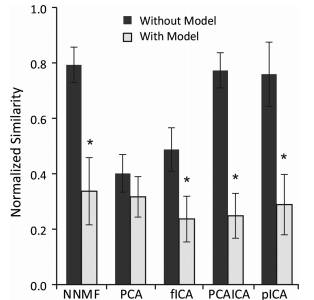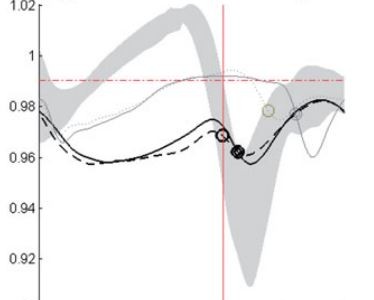Hwan Choi presents at American Academy of Prosthetics and Orthotics:
Changes in gastrocnemius length with AFO-FC tuning
New Orleans, LA (February 18-21, 2015)

Hwan Choi presents at American Academy of Prosthetics and Orthotics:
Changes in gastrocnemius length with AFO-FC tuning
New Orleans, LA (February 18-21, 2015)

Journal article in Journal of Neurophysiology:
Consequences of biomechanically constrained tasks in the design and interpretation of synergy analyses
Matrix factorization algorithms are commonly used to analyze muscle activity and provide insight into neuromuscular control. These algorithms identify low-dimensional subspaces, commonly referred to as synergies, which can describe variation in muscle activity during a task. Synergies are often interpreted as reflecting underlying neural control; however, it is unclear how these analyses are influenced by biomechanical and task constraints, which can also lead to low-dimensional patterns of muscle activation. The aim of this study was to evaluate whether commonly used algorithms and experimental methods can accurately identify synergy-based control strategies. This was accomplished by evaluating synergies from five common matrix factorization algorithms using muscle activations calculated from 1) a biomechanically constrained task using a musculoskeletal model and 2) without task constraints using random synergy activations. Algorithm performance was assessed by calculating the similarity between estimated synergies and those imposed during the simulations; similarities ranged from 0 (random chance) to 1 (perfect similarity). Although some of the algorithms could accurately estimate specified synergies without biomechanical or task constraints (similarity >0.7), with these constraints the similarity of estimated synergies decreased significantly (0.3-0.4). The ability of these algorithms to accurately identify synergies was negatively impacted by correlation of synergy activations, which are increased when substantial biomechanical or task constraints are present. Increased variability in synergy activations, which can be captured using robust experimental paradigms that include natural variability in motor activation patterns, improved identification accuracy but did not completely overcome effects of biomechanical and task constraints. These results demonstrate that a biomechanically constrained task can reduce the accuracy of estimated synergies and highlight the importance of using experimental protocols with physiological variability to improve synergy analyses. PDF

Journal article accepted in Disability and Rehabilitation:
Using musculoskeletal modeling to evaluate the effect of ankle foot orthosis tuning on musculotendon dynamics: a case study.
This case study examines the influence of an ankle foot orthosis footwear combination (AFO-FC) on musculotendon lengths and gait kinematics and kinetics after right thrombotic stroke resulting in left hemiplegia. Methods: Gait analysis was performed over three visits where the subject walked with an AFO-FC with two shank-to-vertical angle (SVA) alignments, a posterior leaf spring AFO (PLS AFO), and shoes alone. Biomechanical and musculoskeletal modeling was used to evaluate musculotendon lengths, kinematics, and kinetics for each condition. Results: The AFO-FC improved walking speed and non-paretic kinematics compared to the PLS AFO and shoes alone. The operating length of the paretic gastrocnemius decreased with the AFO-FC improving knee kinematics in swing, but not stance. As the SVA of the AFO-FC was reduced from 15° to 12°, internal ankle plantar flexor moment increased. Conclusions: Musculoskeletal modeling demonstrated that the AFO-FC altered gastrocnemius operating length during post-stroke hemiplegic gait. Using these tools to evaluate muscle operating lengths can provide insight into underlying mechanisms that may improve gait and guide future AFO-FC design. PDF

Kat Steele presents at Biomedical Engineering Society and is awarded Outstanding Presentation, Neural Engineering Track:
Predicting metabolic costs of pathologic gait in cerebral palsy
San Antonio, TX (October 22-24, 2014)

Paper accepted at ASME Dynamics Systems and Control Conference:
Using dynamic musculoskeletal simulation to evaluate altered muscle properties in cerebral palsy
Abstract: Cerebral palsy is caused by an injury to the brain, but also causes many secondary changes in the musculoskeletal system. Altered muscle properties such as contracture, an increased passive resistance to stretch, are common but vary widely between individuals and between muscles. Quantifying these changes is important to understand pathologic movement and create patient-specific treatment plans. Musculoskeletal modeling and simulation have increasingly been used to evaluate pathologic movement in CP; however, these models are based upon muscle properties of unimpaired individuals. In this study, we used a dynamic musculoskeletal simulation of a simple motion, passively moving the ankle, to determine (1) if a model based upon unimpaired muscle properties can accurately represent individuals with cerebral palsy, and (2) if an optimization can be used to adjust passive muscle properties and characterize magnitude of contracture in individual muscles. We created musculoskeletal simulations of ankle motion for nine children with cerebral palsy. Results indicate that the unimpaired musculoskeletal model cannot accurately characterize passive ankle motion for most subjects, but adjusting tendon slack lengths can reduce error and help identify the magnitude of contracture for different muscles.